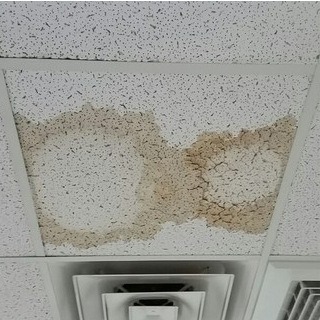Mold in ceiling tile can be a troubling issue for homeowners and property managers alike. Learn about the causes of mold growth, effective prevention strategies, and how to safely remediate mold-infested ceiling tiles to maintain a healthy indoor environment.

Causes of Mold in Ceiling Tiles
Mold growth in ceiling tiles is often triggered by several factors:
- Moisture Accumulation: Leaking roofs, plumbing issues, or high humidity levels can lead to moisture buildup in ceiling spaces, creating ideal conditions for mold growth.
- Poor Ventilation: Inadequate ventilation in bathrooms, kitchens, or basements can contribute to humidity levels that promote mold formation.
- Water Damage: Previous water leaks or flooding incidents that were not properly dried and treated can result in hidden mold growth within ceiling materials.
- Organic Matter: Ceiling tiles made of organic materials such as cellulose or mineral fibers can serve as food sources for mold when exposed to moisture.
Signs of Mold in Ceiling Tiles
Identifying mold in ceiling tiles early is crucial to prevent further spread and potential health hazards. Look out for these signs:
- Discoloration: Dark spots or patches on the ceiling tiles, often green, black, or brown in color.
- Musty Odor: A persistent musty smell, especially in enclosed spaces or rooms with poor ventilation.
- Warped or Bulging Tiles: Moisture absorption can cause ceiling tiles to warp or bulge, indicating underlying mold growth.
Prevention of Mold in Ceiling Tiles
Preventing mold growth in ceiling tiles involves proactive measures to control moisture and improve ventilation:
- Address Water Intrusion Promptly: Repair leaks in the roof, plumbing fixtures, or windows to prevent moisture buildup.
- Monitor Indoor Humidity Levels: Use dehumidifiers in areas prone to humidity, such as basements and bathrooms, to maintain optimal moisture levels (ideally below 60%).
- Improve Ventilation: Ensure adequate ventilation in kitchens, bathrooms, and laundry rooms to reduce moisture accumulation.
- Choose Mold-Resistant Materials: Opt for ceiling tiles that are designed to resist mold growth, such as fiberglass or PVC options.
Remediation of Mold in Ceiling Tiles
If mold is already present in ceiling tiles, it’s essential to handle the remediation process safely and effectively:
- Assessment: Conduct a thorough inspection to determine the extent of mold contamination and identify the source of moisture.
- Containment: Isolate the affected area to prevent mold spores from spreading to other parts of the building during remediation.
- Removal: Remove mold-infested ceiling tiles carefully, following proper safety protocols including wearing protective equipment.
- Cleaning: Clean and disinfect non-porous surfaces adjacent to the moldy tiles to eliminate any residual mold spores.
- Prevention Measures: Implement preventive measures to avoid future mold growth, such as improving ventilation and using mold-resistant materials.
Read too: Kitchen Lighting For A Vaulted Ceiling: Illuminating Your Space with Style and Functionality
Conclusion
Dealing with mold in ceiling tile requires prompt action to mitigate potential health risks and structural damage. By understanding the causes of mold growth, implementing preventive strategies, and following safe remediation practices, homeowners and property managers can maintain a mold-free environment and ensure the longevity of their ceiling structures.